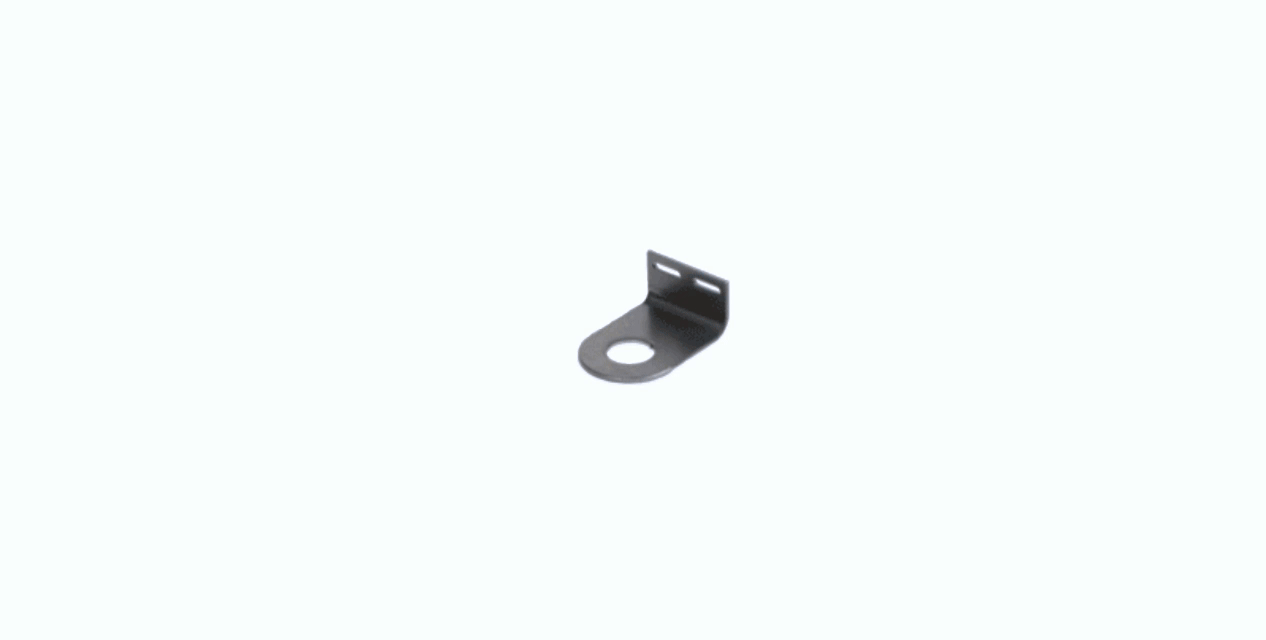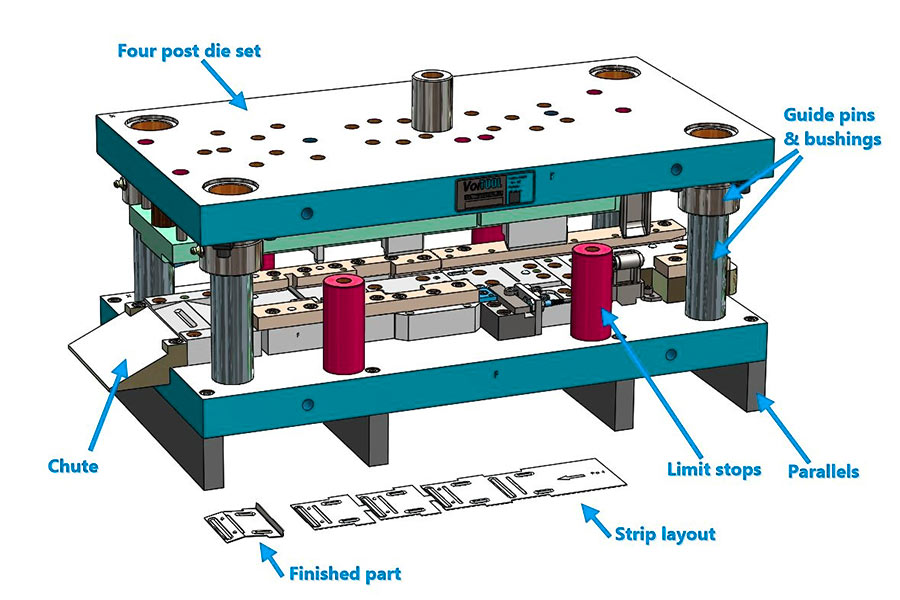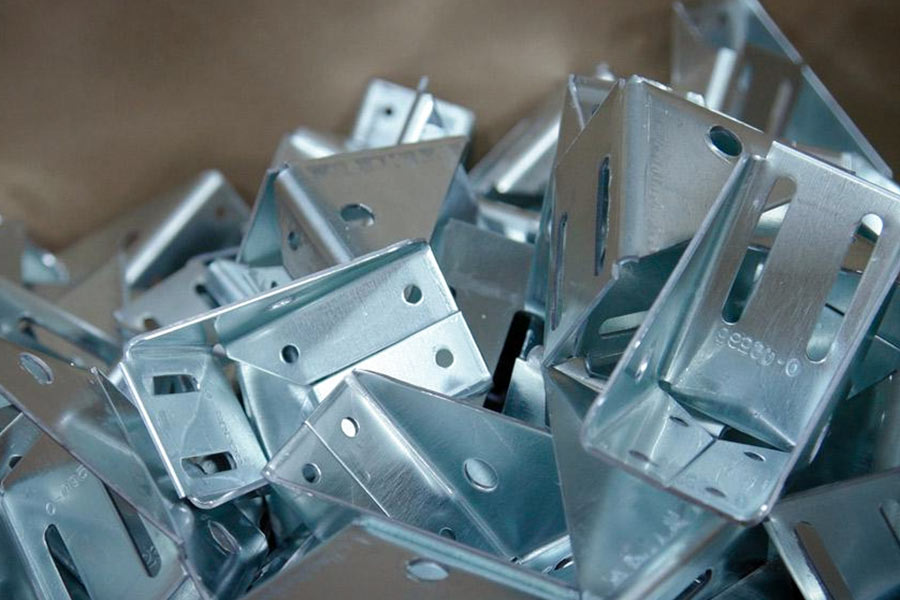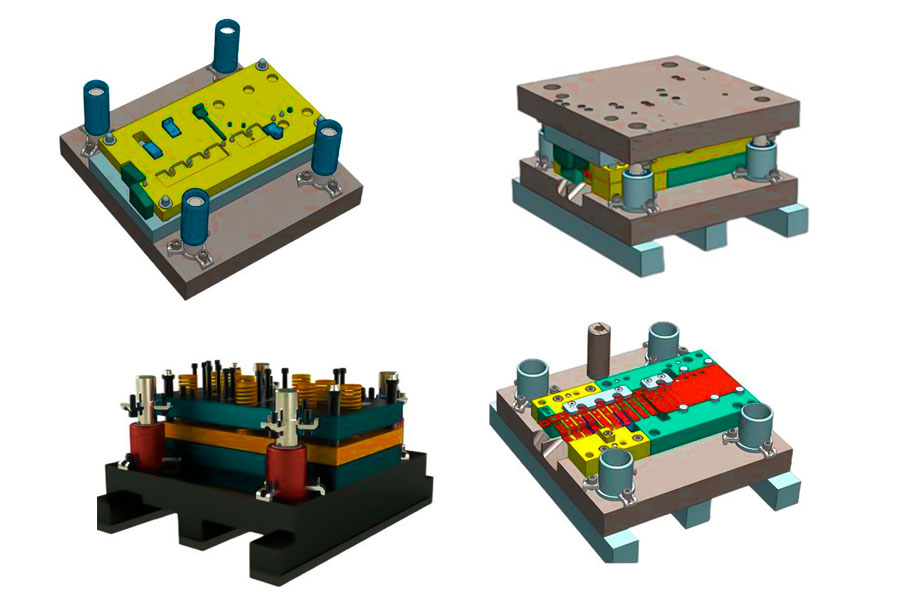Metal stamping is an advanced manufacturing technology, through professional die and punch to effectively transform metal sheets into precision metal products. In this process, the choice of material directly determines the performance and application scenario of metal stampings.
With the increasing demand of precision manufacturing, special metals such as titanium alloys and magnesium alloys gradually infiltrate the fields of aerospace and consumer electronics fields. The design and precision of metal stamper further enhances the material's potential to meet a wide range of needs, from tiny electronics to large car casings. Reasonable selection can not only optimize the strength, conductivity or weather resistance the product, but also control the cost effectively by reducing processing losses, which is the key to metal stampings in industrial manufacturing.

What is metal stamping?
Metal stamping is a process of stamping on metal sheets with molds and press. It is widely used in automobile, electronics and home appliances. At the core of this paper, a high precision die is used to form metal sheets at a time, which can produce metal stampings with complex shape and micrometer level tolerances. The process not only greatly improves material utilization rate, but also greatly reduces production cost through automated production line, especially suitable for large-scale standardized components manufacturing. With the development of precision stamping technology, modern metal stamping has been able to meet the strict requirements of strength, conductivity and corrosion resistance in high end fields such as aerospace and medical equipment.

What is metal stamping material?
The type of metal stamps material directly affects the processing effect and product performance. The following are common classifications and characteristics of metal stamp materials:
1.Stainless Steel
Stainless steel is a material widely used in metal stamping. Because of its corrosion resistance and high strength, it is commonly used to manufacture components that require hygienic standards, such as medical equipment and food processing equipment. During the stamping process, by adjusting the mold and pressure parameters, the surface smoothness can be maintained and complex shapes can be formed with high precision.
2. Aluminum and aluminum alloy
Aluminum is lightweight and easy to handle. Suitable for fast quality production of electronic equipment casing, automotive components, ETC. It has good ductility, can reduce mold wear and improve production efficiency, and is especially suitable for weight-sensitive applications.
3. Copper and copper alloy
Copper has a high conductivity and is commonly used in the manufacture of electrical connectors and radiators. Thin-walled copper parts can be used in accordance with high-frequency welding or assembly requirements precise stamping process.
4.Carbon Steel
Carbon steel has high strength and low cost. This is for automotive chassis and fasteners. During the processing, the pressure parameters should be adjusted according to the thickness of the material to avoid the impact of rebound deformation on dimensional accuracy.
5. Titanium Alloy
Titanium alloys can withstand high temperatures and corrosion. It is a common material in the aerospace industry. It has high hardness, high wear resistance to death, and needs to be used in combination with precise stamping technology for stable molding.
6. Galvanized Steel
Galvanized surface enables it to resist rust. It is widely used in household appliance panels, roof building materials, etc. In this process, temperature and pressure should be controlled to prevent the peeling of the zinc layer from affecting the adhesion of the coating.

What pretreatment is required before printing metal material?
Pretreatment of metal materials before stamping is a critical step in ensuring quality,The accuracy and productivity of stamp parts. The main preprocessing process and related technical highlights are as follows:
1. Material Cutting
Purpose: Cut the sheet metal to the desired size to avoid curling or deformation.
JS Technology Association: Accuracy laser cutting or cutting technology can be ±0.02mm, which can ensure the stability of the billet size.
| Method | Applicable solutions | JS Advantages |
| Laser cutting | Precision shape parts. | Contactless treatment, small heat-affected zone. |
| Flating the computer | Large panel material. | Eliminate residual stress and achieve a flatness of 99%. |
2. Surface cleaning and removal of rust
Usage: Used to remove oil stains, oxidation scales and rust, and prevent mold contamination or workpiece adhesion.
JS Technology Association:
- Use environmentally friendly detergents (compliant with ROHS standards) with ultrasonic cleaning technology.
- Automatic phosphoric acid/passivation production lineImproving surface coating adhesion.
| Processing method | role | JS environmental protection measures |
| Alkaline degreasing | Remove grease. | The compliance rate for wastewater treatment is 100%. |
| Power | Improve surface smoothness (RA≤0.1μm). | Reduce energy consumption per unit product by 30%. |
3. Luxile coating
Purpose: Accurately adjust the molding friction coefficient (μ≤0.08), and exceed 30% of the mold life, Surface roughness ≤0.8μm.
JS Technology Association: JS materials are widely selected (covered over 50 varieties) to optimize stamping efficiency (Project cycle time reduction by 15%) is based on different metal combinations with special lubricants.
4. Relieve stress and annealing
Purpose: To eliminate internal pressure of the material, improve ductility and prevent the stamp from breaking.
JS Technology Association:
- Vacuum annealing furnace achieves precise temperature control (±5°C) to avoid oxidation.
- Fast cooling technology shortens process cycles and increases efficiency by 25%.
| Process type | Applicable solutions | JS Quality Control Indicators |
|
Pressure relief annealing
|
Cold rolling steel plate stamping. | Residual stress ≤30mpa. |
| Full annealing | Formation of high-strength steel. | The grain size uniformity complies with the ASTM standard. |
5. Accurate calibration and positioning
Purpose: To ensure the dimensional accuracy and consistency of stamped parts.
JS Technology Association:
- 3D Blu-ray scanner detected the shape and position tolerance of the billet, and the error compensation rate reached 98%.
- The automatic feeding system integrates visual positioning technology with positioning accuracy ±0.01mm.
| Technical means | Function | JS technical advantages |
| Optical alignment | Complex artifact positioning. | Automatically corrected, yield increased to 99.5%. |
| Press before mold | Compend on material thickness deviation. | Tolerance control is up to ±0.005mm. |
Overview of the advantages of JS company's preprocessing technology
| aspect | Technical characteristics | Customer revenue |
| Precise control | Multi-sensor joint control + AI algorithm optimization. | Tolerance compliance rate> 95%. |
| Improve efficiency | Full automatic assembly line + modular process. | Reduce delivery time by 15-20 days. |
| Cost optimization | Standardization of Waste Recycling System+ Process Parameters. | Reduce unit cost by 12-18%. |
| Environmental Compliance | Clean production + 100% utilization of waste resources. | Complied with the EU Environmental Directive. |
Through the above pretreatment process, JS Company can ensure the accuracy and quality of stamped metal products while ensuring the maximum material performance of stamp metal products.
How can high-strength materials improve the durability of stamped parts?
1.Enhanced resistance to deformation
High-strength materials such as high-strength steel and titanium alloys have high yield and tensile strength, which can significantly improve the deformation resistance of metallic stamps under dynamic load. for example, after stamping of high strength steel, theimpact reslstance ot car chassis components increases bv 40%, eftectvelv avoicina structural tatiaue caused bv ona-term vibration.
2.Extended fatigue life
The crystal structure of high strength materials is dense, which can delay crack propagation. In metal stamped, such as titanium alloy stamping used in aircraft engine blades, fatigue life can reach 2-3 times that of traditional materials and meet therequirements of high frequency mechanical stress cycling.
3.Resistance optimization
High-strength materials, such as high-carbon steel or surface hardening, can reduce friction losses by increasing hardness, such as HV or above. For example, when carbon steel is used for metal stamp, the abrasion resistance of gear metal stamp increases by 60%, prolonging service life and reducing maintenance frequency.
4. Improving corrosion resistance
High strength materials (such as stainless steel) have inherent properties of acid and alkali resistance and oxidative resistance. For example, metallic stamp for coastal equipment are stamped with 316 liters of stainless steel, which can be maintained in a salt spray environment for more than 10 years without any signs of corrosion, thus greatly reducing replacement costs.
5.Balance of weight and strength
Some high-strength aluminum alloys,such as 7075, are lightweight while retaining their strength, When used with metallic stamps they can reduce weight (for example, by 30% for car components) while maintaining structural stability. They are suitable forsituations where weight sensitivity and high durability are required.
6. Enhanced temperature adaptability
Titanium alloys and other materials can maintain their strength at high temperatures (>400°C) or low temperatures (<-50°C) and work steadily under extreme conditions, For example, spacecraft seals need to withstand a temperature difference of -100°C to 200°C to ensure sealing.
Technical Implementation Path
| Material type | Strength index | Typical application solutions | Durability improvement effect |
| High strength steel (HSS) | Yield strength ≥800MPa | Car collision beam, gear. | Extended service life by 50% to 200%. |
| Titanium alloy (TI-6AL-4V) |
Tensile strength ≥900MPa
|
Aviation components, implants. | Extend fatigue life 2-3 times. |
| High strength aluminum alloy (7075) |
Tensile strength ≥570MPa
|
Drone frame, 3C shell. | Weight loss was 30%, but intensity remains the same. |
By selecting suitable high-strength material and combining it with precision metallic stamp technology, the overall durability of stamped parts can be greatly improved and the industry's strict requirements for long-term reliability can be met.
How to prevent rust treatment on stainless steel stamped parts?
1.Surface cleaning and removal of pollutants
Uses: Removing oil, cutting fluid, metal debris and other pollutants in stamping process to avoid oxide film damage.
JS measures:
- A combination of alkaline degreaser and ultrasonic cleaning process was used to achieve Sa2.5 level (ISO standard) cleanliness.
- Automated phosphating/passivation production line to form uniform protective layer on treated surface.
Main operations:
- Brush the surface oil stains with a clean cloth immediately after stamping.
- Chlorine-containing solvents such as hydrochloric acid are prohibited to prevent stress corrosion and cracking.
2.Chemical passivation treatment
Objective: To improve the density and corrosion resistance of stainless steel surface oxide film (CR₂O₃).
JS measures:
- Environmentally friendly passivation solution (free of hexavalent chromium) meets RoHS standards.
- Passivated salt spray test last more than 240 hours (304 stainless steel as standard).
Process parameters:
- Temperature: Normal ~50 °C (adjusted for material).
- Time: 15-30 minutes.
Post-treatment: Rinse + dry with pure water to ensure no residue.
3.Physical protection coating
Purpose: Physical isolation layer for special environment such as high humidity and chemical medium.
JS measures:
- Electrophoretic coating: Epoxy resin coating, salt-resistant spray time up to 500 hours.
- PVD vacuum coating: Deposition chromium nitride film, hardness HV 2000+, increase abrasion resistance.
4.Structural design and process optimization
Objective: To reduce stress concentration, surface damage and corrosion risk.
JS measures:
- Hard chromium (Ra ≤ 0.1μm) on die surface to avoid stamping scratches.
- Hydraulic forming is used instead of traditional stamping to reduce strain on the material.
Design highlights:
- Rounded transition: Avoid stress concentration caused by sharp angles.
- Exhaust design: Avoid liquid accumulation inside the stamped parts.
5.Environmental control and maintenance
Purpose: To block external corrosion sources and prolong rust prevention time.
JS measures:
- Storage environment: Constant temperature and humidity warehouse (moisture ≤60%).
- Transport protection: Wrapped in polyethylene film and filled with desiccant, moisture-proof and rust.
- Periodic maintenance: Check surface condition monthly, treat small rust spots with a professional stainless steel cleaning, and repair local passivation of welded areas.

What are the difficulties in designing stamping molds for irregular parts?
The dificulty of stamping die design for irregular parts involves many technical challenges and requires a combination of precisionmanufacturing experience and innovative solutions. Here are specific difficulties and how JS company's response strategies:
1.Design challenges posed by structural complexity
Difficulties:
- Split die design: Irregular parts usually require a multi-cavity die or slider structures with a high mold complexity (e.g. 7-8 slider linkage for car coverings).
- Core extractor: For deep stretching or lateral core extractor parts, precision core is needed, otherwise mold jamming or size deviation may occur.
- Mold strength: Complex structures are prone to stress concentration and topology optimization is required to improve stiffness.
Response strategies:
- Modular design and individual manufacturing of key components.
- The force distribution of die is optimized by FEA.
2.Material utilization and layout optimization
Difficulties:
- Irregular parts are prone to waste layout process, resulting in material utilization rate less than 60%.
- Complex contours require a balance between stamping sequence and deformation control.
Response strategies:
- Samples are automatically optimized and arranged using AI algorithms.
- The universal edge cutting technology reduces waste.
3.Accuracy control and dimensional stability
Difficulties:
- The tolerances for irregular parts (e.g. electronic components stand ±0.02mm) are strictly required.
- Stamping recoil results in size bias (stainless steel recoil rate can be 8%-12%).
Response strategies:
- Real-time on-line detection system (CCD+laser ranging).
- The surface of the die is modified by the rebound compensation algorithm algorithm.
4.Service life and abrasion resistance of mold
Difficulties:
- The stamping frequency of irregular parts is limited (500000 times the service life of ordinary moulds and more than 2 million times the service life of highly demanding parts).
- The welding process of hard alloy and mold steel is difficult.
Response strategies:
- Surface hardening (e.g. TD coating, PVD coating).
- The abrasion area was repaired by laser cladding.
5.Trial Mode Cost and Efficiency
Difficulties:
- Irregular parts have long test die cycles and cost more than 10000 yuan per piece.
- Traditional methods of trial and error are difficult to locate the root cause of the problem quickly.
Response strategies:
- Digital twin technology simulates the stamping process.
- Rapid prototyping molds (3D printing) shorten the verification cycle.

How does JS company optimize the utilization rate of stamping materials?
1.Intelligent layout design
Technical means:
- Artificial intelligence algorithm is used to arrange stamp metal intelligently and calculate the most optimal nesting scheme automatically.
- Support for uploading STEP/IGES and other formatting files, the system automatically recognizes part contours and generates a layout.
Effect: Material utilization rate increased from 85% of the industry average to over 92% (especially irregular parts). Reduce waste and save approximately 15% to 20% on materials per order.
2.Residual material recycling and reuse system
Technical means:
- Fully automated waste sorting equipment is provided for the real-time classification of recyclable metal debris, such as stamping metal scraps.
- The remaining material is processed into small stamping parts by thermopressing process.
Effect: Meet the standard of sustainable production, a non-ferrous metal recovery rate up to 98%, reduce annual raw material procurement costs of more than 1 million.
3.Modular process, flexible production line
Technical means:
- The complex parts are broken down into standardized submodules (such as holes and bending areas) and batch processing using a uniform molds.
- Seamless switching of different stamp metal parts is achieved through the rapid die conversion system, and the changeover time is no more than 15 minutes.
Effect: 30% shorter lead time and 10% less material loss for multi-variety small order.
4.Material Characteristics and Process Matching Database
Technical means:
- There is a database of more than 50 metallic materials, including parameters such as thickness, ductility and resilience.
- Automatic stamping process parameters are generated to avoid waste due to improper material selection.
Effect: High strength steel (such as 430 stainless steel) stamping qualification rate increased to 99.5%, reducing rework waste.
5.Digital simulation and virtual debugging
Technical means:
- AutoForm software is used to simulate the stamping process of stamp metal and predict defects such as wrinklings and fractures.
- The mold surface is optimized by virtual debugging and the number of die physical tests is reduced.
Effect: 100% pass rate of mold initial inspection, 100% trial mold cycle.
Summary
In the field of metal stamping, the choice of materials directly determines the performance and quality of metal stamped products. From aluminum alloy to stainless steel, each material meets the precision needs of different industries with its unique properties. JS company has advanced metal stamps technology and the flexibility to select more than 50 metal materials according to customer needs. The precision level of metal stamped is ±0.005mm by optimizing mold design and production process. Whether it's the impact resistance of car coverings or the corrosion resistance of medical devices, JS's professional team is able to create a fully functional and cost-effective metal stamping solution for customers.
Disclaimer
The content of this page is for informational purposes only.JS SeriesNo representations or warranties of any kind, express or implied, are made as to the accuracy, completeness or validity of the information. It should not be inferred that the performance parameters, geometric tolerances, specific design features,material quality and type or workmanship that the third-party supplier or manufacturer will provide through the jusheng network. This is the responsibility of the buyerAsk for a quote for partsto determine the specific requirements for these parts.please Contact us Learn more information.
JS Team
JS is an industry-leading companyFocus on custom manufacturing solutions. With over 20 years of experience serving more than 5,000 customers,we focus on high precisionCNC machining,Sheet metal fabrication,3D printing,Injection molding,metal stamping,and other one-stop manufacturing services.
Our factory is equipped with more than 100 state-of-the-art 5-axis machining centers and is ISO 9001:2015 certified. We provide fast, efficient and high-quality manufacturing solutions to customers in more than 150 countries around the world. Whether it's low-volume production or mass customization, we can meet your needs with the fastest delivery within 24 hours. chooseJS TechnologyIt means choosing efficiency, quality and professionalism.
To learn more, please visit our website:jsrpm.com
FAQs
1.What are the advantages of stainless steel stamping parts?
Stainless steel stamping parts is corrosion resistant, abrasionresistant and high strength. It is suitable for long-term use in home appliances, medical devices and so on.
2.What are the materials with good ductility?
Including aluminum alloy, copper alloy, brass and pure metals such as gold, silver, aluminum, these materials are easy to shape, suitable for complex stamping parts processing.
3.How does the thickness of metal sheet affect the stamping effect?
Thin plate is easy to deform, but the strength is low. It is suitable for precision parts. Thick plates require greater punching force and are prone to burr, making them suitable for structural components. The die clearance and pressure parameters need to be adjusted according to the ductility of the material.
4.Is the dimensional accuracy of metal stamping parts related to the material?
Closely related to this, the ductility, bounce and uniformity of the material directly affect the stability of the molding and need to be controlled through mold design and process parameter optimization.






